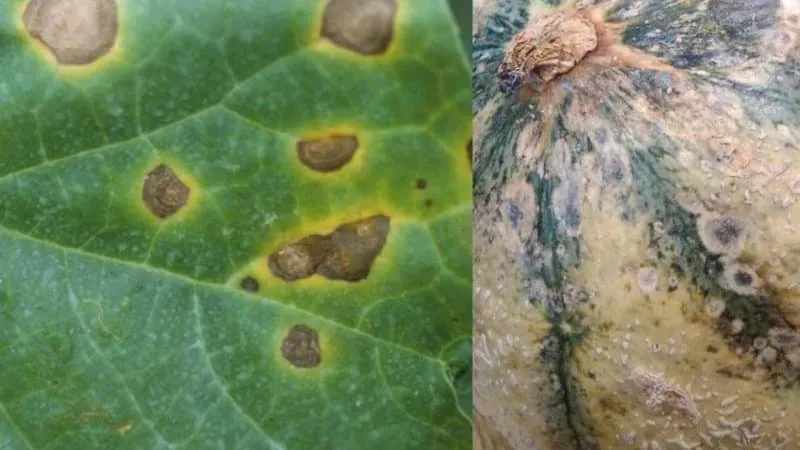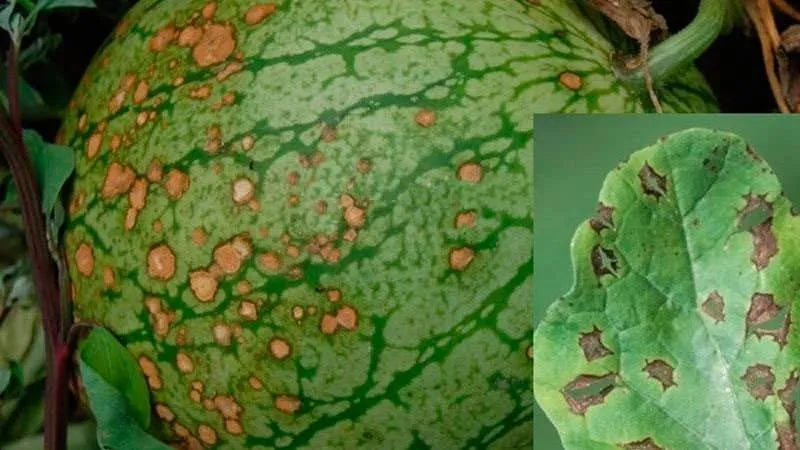Watermelon diseases, their prevention and treatment – the main concern for gardeners when cultivating this demanding melon crop. Besides creating optimal growing conditions, watermelons require careful maintenance and timely detection of disease symptoms.
To prevent plant loss, it is crucial to correctly identify the pathogen and eliminate it. Let’s examine the most common diseases and methods to combat them.
Table of contents
Common Watermelon Diseases
Watermelon diseases are primarily fungal in origin, with a few caused by viruses. Almost any disease can leave a gardener without a harvest, even at the seedling stage. Recognizing symptoms, treatment methods, and constant monitoring will help preserve the fruits.

Anthracnose
Anthracnose (copperhead) – a disease capable of causing significant damage to the crop. Infected plants may produce rotten fruits and wither. The causative agent is a phytopathogenic fungus.
Brown or yellowish irregular spots appear on leaves, expanding over time, leading to deformed ovaries and stunted growth. Brown or black spots also develop on stems and fruits.
Note. Wet seasons favour disease development. During vegetation, the infection spreads via insects, careless watering, rain, or wind.
To combat the disease, regulate watering to avoid excessive soil moisture and ensure proper ventilation and light exposure. At early stages, "Previcur" can be used for treatment.
Key preventive measure – destroy post-harvest residues. Rotate watermelons every 6–7 years and disinfect seeds before planting.
Root Rot
A fungal disease. Pathogens infect the soil, then the root system, eventually killing the plant. Symptoms include brown, waterlogged spots at the stem base, yellowing leaves, and cracked roots.
Cold, wet weather and temperature fluctuations promote root rot. Avoid overwatering, aerate soil, and fertilize regularly.
Remove dried and weedy plants, disinfect soil with potassium permanganate, and treat watermelons with a 0.1% "Fundazol" solution.
Powdery Mildew
White, powdery spots appear, first on older leaves, then spreading to young foliage. Fruit development slows, and deformities occur. Affected watermelons lose sweetness and juiciness.
Spray infected plants with calendula, dandelion, or garlic solutions.
Preventive measures:
- During vegetation, treat plants with disinfectants ("Cuprazan");
- Fertilize every 7–10 days with crushed chalk/lime;
- Soak seeds in "Immunocytophyte" before sowing.
Downy Mildew
Also called false powdery mildew. Symptoms include large brown spots with an oily film, drying leaves, purple underside leaf coating, and halted fruit growth. Infected parts turn brown and die.
Treat with copper oxychloride or "Acrobat." Remove infected parts and disinfect tools regularly.
Mosaic Virus
Rare in watermelons. Two types exist: cucumber mosaic and green mosaic. Cucumber mosaic deforms leaves, causing yellow-green patches. Green mosaic causes swelling but rarely mottling, mostly in greenhouse plants.
Note. The virus spreads via aphids in warm seasons and plant residues in cold periods.
No cure exists. Destroy infected plants. Spraying "Carbophos" weekly may help if detected early.
Fusarium Wilt
A fungal disease attacking roots. Early detection is difficult. Symptoms include orange root spots with pinkish coating. Advanced stages are untreatable.
Remove infected plants, treat soil with copper sulphate. Use fungicides preventively. Early-stage treatment: wood ash + colloidal sulphur (1:1) in water.
Bacterial Spot
One of the most common diseases, potentially destroying 50% of crops.
Symptoms:
- Watery spots with yellow-green edges merging over time;
- Dark, round growths on fruits;
- Blackening leaves.
Remove infected plants. Early-stage treatment involves cutting affected leaves, disinfecting tools, and soil treatment.
Rot (White, Grey)
Develops in high humidity and cold weather. Caused by parasitic fungi.
White rot shows cotton-like white coating on lower leaves, turning dark. Grey rot causes brown, watery spots with grey-black mould.
Destroy severely infected plants. Early-stage treatment: remove affected parts, apply "Acrobat" or "Topaz" weekly.
Note. Planting marigolds, calendula, or mustard around melons prevents fungal infections due to their phytocide release.

Leaf Rust
Caused by parasitic rust fungi. Symptoms: brown bumps on leaves releasing rusty spores.
Prune infected parts, apply fungicides. Reduce nitrogen fertilizers as prevention.
Olive Spot
A fungal disease affecting all above-ground parts. Fruits develop grey-olive ulcers oozing fluid. Untreated plants die in 5–10 days.
Use "Cartocide" or "Oxyhom." Early-stage treatment: Bordeaux mixture.
Why Watermelons and Vines Turn Black
Blackening watermelons – a common issue. Caused by unfavourable climates, especially frost. Without intervention, the crop is lost.
In greenhouses, artificial heating helps. In open fields, choose optimal planting locations and timing. Ensure good light, ventilation, proper watering, and crop rotation.
Fungal diseases like anthracnose and fusarium also cause blackening.
Watermelon Pests and Control
Pests also threaten watermelon crops.
Common pests:
- Melon Aphid. Destroys flowers and ovaries. Repel with onion, garlic, or tobacco infusions. Use insecticides if severe.
- Spider Mites. Webbing on flowers and shoots. Use acaricides: "Omite," "Neoron," "Apollo."
- Wireworms. Bore holes in fruits, causing rot. Use traps or "Diazonin," "Zemlin."
- Seedling Fly. Larvae attack seedlings and mature plants. Treat seeds with "Fentiuram," spray plants with "Iskra Bio."
- Thrips. Tiny black dots on leaves. Use "Spintor," "Vertimec," or "Karate." Remove affected parts.
Note. Home remedies work only in early infestation stages.
Preventive Measures
Prevention is the most effective method, as pathogens survive years in soil, tools, and plant debris.
Key prevention methods:
- Use healthy, disinfected seeds.
- Plant in well-ventilated, sunny areas, avoiding previous cucurbit crops for 3–4 years.
- Regularly aerate soil.
- Fertilize with nutrients.
- Maintain optimal soil and air temperatures.
- Avoid wetting leaves during watering (use water at 22–25 °C).
- Do not store damaged fruits with healthy ones.
- Burn plant residues in previously infected areas.
- Autumn ploughing to invert soil layers.
Conclusion
Proper care and prevention minimize disease risks. Modern fungicides, insecticides, and home remedies help if issues arise. Advanced infections require destroying affected plants.







